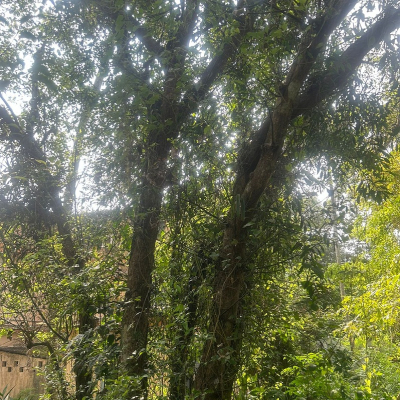Distribution and habitat: Native to China and Japan, cultivated in Nilgiri Hills of India.
Botany: A handsome, profusely branched, evergreen tree, 30 m in height.
- Leaves: Simple, alternate, leathery, shiny, aromatic, long petiolate, ovate or oblong, 3 nerved, 5-10 cm long, 2.5-5 cm broad, uniformly coloured on both sides or below paler or glaucous..
- Flowers: Yellowish white in axillary panicles, calyx slightly longer than the pedicels, about 3 mm long.
- Fruits: Dark green, ovoid or globose, turning black on ripening.
Properties: Stimulant, carminative, sedative, anodyne, antispasmodic, diaphoretic and anthelmintic. The camphor is formed in the oil cells distributed in all parts of the tree but is obtained mainly from leaves and also from the stems by distillation.
Chemical constituents: Essential oil contains sesquiterpenes, campherinone and campherenol. Roots: alkaloids, laurolistsine, and reticuliene. Leaves: palmitone. Heart wood: cyclopentanone.
Uses: It is used in inflammations, cardiac debility, asthma, cough, dyspepsia
Agro technology:
Soil and climate: Plant can be successfully cultivated where rainfall is up to 1000 mm/ annum. Fertile, well drained sandy loam soils are best suited for cultivation of camphor tree. Deeply tilled clayey soils are also suitable, provided rendered porous by mixing leaf mould and sand supplimented with artificial fertilizers.
Propagation: Propagation is chiefly through seeds and rarely through layers, branches, cuttings, root cuttings and root suckers. Fresh ripe fruits are collected either direct from tree or soon after they fall. Removal of pulpy seed coat and presoaking of seeds in water for 24 hours enhances seed germination. Seeds are sown in nursery at a spacing of 6‑8 cm in rows of 25‑30 cm apart and irrigated regularly. Seeds start germinating after 3 months of sowing. Nursery is maintained weed free. After 12‑16 months seedlings are transplanted in main field in 60 cm3 pits, 2‑3 m apart.
Manures and Fertilizers: Application of organic manures and inorganic fertilizers has proved beneficial. Plants are trimmed to a height of 1.5‑2 m and maintained as bushes to facilitate picking of leaves.
Pests and diseases: Leaf blight disease in camphor is caused by Glomerella singulata which can be controlled by spraying difolatan and benlate.
Harvesting: Leaves and twigs are harvested every year and distilled to produce camphor oil. Wood over 50 years of age is also used for distillation. Bushes are harvested 3‑4 times a year.
Processing: Camphor oil is obtained by distilling leaves, twigs and wood. Crude camphor oil is separated in various fractions as white, brown and blue camphor oils. White camphor oil is generally not used as such in perfumes, but it serves as a starting material for production of a number of perfumery chemicals such as cineole, terpineol, menthol and thymol. There is little difference in total yield of camphor when two or four pickings are taken in a year. Tender leaves and plants grown in open contain more camphor. Yield of camphor and camphor oil is 50‑80 kg/ ha which varies widely with part used and geographical location.

